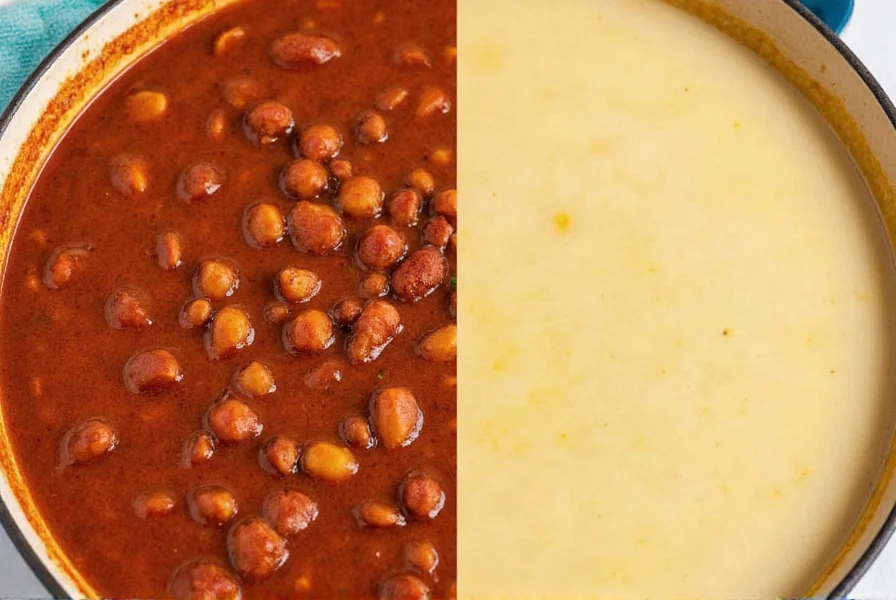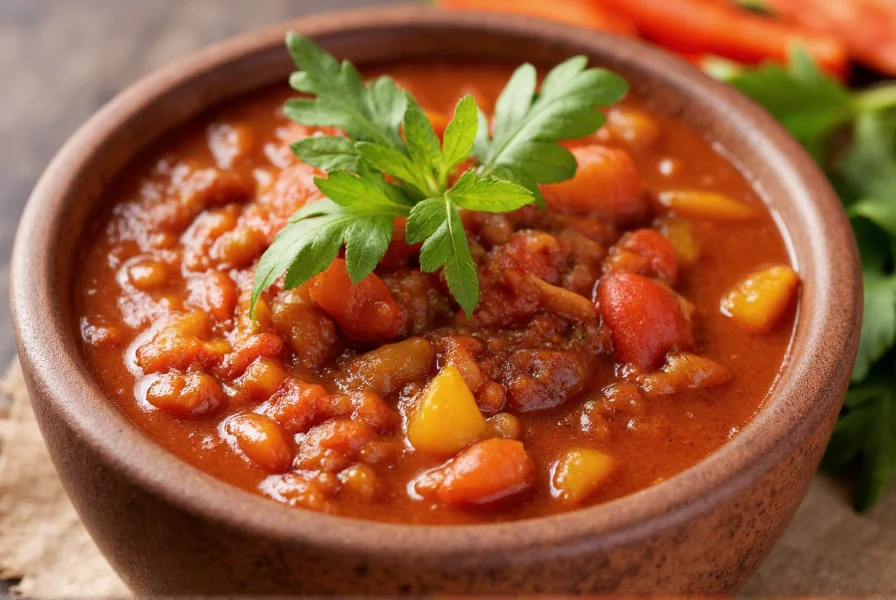When exploring the culinary classification of chili, many home cooks and food enthusiasts wonder: is chili considered soup? The answer requires understanding both culinary definitions and cultural perceptions. While chili contains liquid and is served hot like soup, its preparation method, ingredient ratios, and final texture place it in a different category according to most culinary authorities.
Defining Soup vs. Chili: Culinary Fundamentals
Soup traditionally features a liquid base—typically broth, stock, or water—that constitutes the majority of the dish's volume. The liquid should be substantial enough to drink from a cup. In contrast, chili's defining characteristic is its thick, hearty consistency where solid ingredients like meat, beans, and vegetables dominate, with just enough liquid to create a stew-like texture.
The culinary definition of chili centers on its origins as a Tex-Mex dish featuring meat (usually beef), chili peppers, tomatoes, and often beans, simmered slowly to develop deep flavors. Authentic chili connoisseurs argue that true chili should contain no beans—a point of contention among regional variations.
| Characteristic | Soup | Chili |
|---|---|---|
| Liquid-to-solid ratio | Liquid predominates (60%+) | Solids predominate (60%+) |
| Primary cooking method | Simmering ingredients in liquid | Slow braising of meat with minimal liquid |
| Texture | Pourable, drinkable | Thick, spoon-stands-up consistency |
| Traditional serving vessel | Bowl or cup | Deep bowl (not drinkable) |
| Key flavor development | From broth/stock | From meat and spice searing |
Historical Context: The Evolution of Chili
Understanding why chili isn't soup requires examining its historical roots. Chili originated among indigenous peoples of the Americas who combined meat, peppers, and spices in earthenware pots. Spanish colonists later added beef, creating the foundation for modern chili.
Unlike European soup traditions that evolved from broth-based preparations, chili developed as a standalone meal where the liquid component serves primarily to tenderize meat rather than create a drinkable base. This fundamental difference in purpose—chili as a complete meal versus soup as either an appetizer or component of a meal—further distinguishes the two categories.

Culinary Authority Perspectives
Professional chefs and culinary institutions consistently classify chili separately from soup. The Food Lover's Companion defines chili as "a piquant stew of meat, chili peppers, and other seasonings." Similarly, the Culinary Institute of America categorizes chili under "stews and braises" rather than soups in their curriculum.
When examining chili versus soup classification, food scientist Dr. Harold McGee explains: "The distinction lies in the Maillard reaction process. In chili, meat is browned first to develop complex flavors before adding minimal liquid, whereas soup typically begins with a liquid base to which ingredients are added."
Regional Variations and Cultural Perceptions
The is chili a soup debate often reflects regional culinary traditions. In Cincinnati, chili is served over spaghetti with cheese—a preparation that shares more characteristics with sauce than soup. Texas-style chili contains no beans and has an even thicker consistency than other varieties.
Despite these distinctions, some commercial products market "chili soup," contributing to public confusion. Food labeling regulations allow this terminology since chili contains liquid, but culinary professionals maintain the technical distinction between the categories.

Practical Implications for Home Cooks
Whether you're cooking chili that's not too soupy or adjusting recipes, understanding this classification helps achieve desired results. To prevent chili from becoming soup-like:
- Start with properly seared meat to develop flavor before adding liquid
- Use tomatoes in paste form rather than diced for thicker consistency
- Add beans (if using) late in cooking to prevent excess breakdown
- Simmer uncovered to reduce liquid if needed
- Include thickening agents like masa harina rather than additional broth
Conversely, if you prefer a soupier chili, gradually add broth while maintaining the stew-like character that defines authentic chili preparation.
Conclusion: Resolving the Classification Question
The question is chili considered soup ultimately depends on whether you're applying strict culinary definitions or colloquial usage. Technically, chili belongs to the stew category due to its preparation method and final texture. However, in everyday conversation, many people loosely refer to chili as soup—particularly when comparing it to other liquid-based dishes.
What matters most is understanding the characteristics that define each category, allowing you to prepare and appreciate both soups and chili according to their unique culinary traditions. Whether served in a bowl or mug, chili's rich history and distinctive preparation methods cement its place as a category unto itself.
Frequently Asked Questions
Is chili technically classified as a soup?
No, chili is not technically classified as soup in culinary terms. It falls under the category of stews or casseroles due to its thick consistency where solid ingredients predominate (60% or more) and minimal liquid base. Traditional soups have a liquid base that constitutes the majority of the dish's volume and should be substantial enough to drink.
What makes chili different from soup?
The primary differences are in texture, preparation method, and ingredient ratios. Chili has a thick, spoon-standing consistency with solids predominating, while soup features a liquid base that constitutes most of the dish. Chili is prepared by first browning meat to develop flavor before adding minimal liquid, whereas soup typically begins with a liquid base. Authentic chili also contains specific ingredients like chili peppers and often beans that aren't standard in most soups.
Why do some people call chili soup?
Some people colloquially refer to chili as soup because it's served hot in a bowl and contains liquid. Commercial products sometimes market "chili soup" which contributes to the confusion. Additionally, certain regional variations like Cincinnati chili (served over spaghetti) have a thinner consistency that might resemble soup. However, culinary professionals maintain the technical distinction between the categories based on preparation methods and final texture.
How can I prevent my chili from becoming too soupy?
To maintain proper chili consistency: 1) Start with properly seared meat to develop flavor before adding liquid, 2) Use tomato paste instead of diced tomatoes for thickness, 3) Add beans later in cooking to prevent excess breakdown, 4) Simmer uncovered to reduce liquid if needed, and 5) Incorporate thickening agents like masa harina rather than additional broth. Remember that authentic chili should have a thick, hearty texture where a spoon can stand upright.
Does traditional chili contain beans?
Authentic Texas-style chili traditionally contains no beans. The original chili recipes from Texas chili competitions feature only meat (typically beef), chili peppers, spices, and sometimes tomatoes. Beans were added later as a regional variation and cost-saving measure. Many chili connoisseurs consider beans non-traditional, though they're common in everyday home cooking across much of the United States.











 浙公网安备
33010002000092号
浙公网安备
33010002000092号 浙B2-20120091-4
浙B2-20120091-4